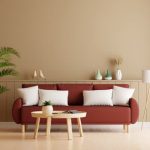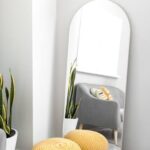Over the past few years, there has been a growing interest in vintage interior design, with one particular trend capturing the hearts of homeowners and designers alike: the resurgence of 1970 boho home decor. This carefree and eclectic style, characterized by vibrant colors, natural materials, and a mix of global influences, is making a comeback in both nostalgic hearts and contemporary homes.
In this blog post, we will delve deep into the factors behind this revival and showcase popular 1970 boho home decor elements that you can incorporate into your own space.
The 1970s evoke a sense of nostalgia for simpler times and carefree lifestyles. It was an era defined by freedom of expression, individuality, and a rejection of societal norms – traits that resonate strongly with today’s homeowners seeking authenticity in their living spaces.
There is an emotional connection people feel towards 1970 boho home decor as it taps into their desire for a cozy, nostalgic atmosphere. The vibrant colors, natural materials like rattan and macrame, and abundant plant life create a sense of warmth and comfort that is hard to resist.
In this blog post, we will explore not only the characteristics and aesthetics of 1970 boho home decor but also how to incorporate vintage furniture and accessories into modern spaces. We will also provide DIY project ideas on a budget to help you capture the essence of this style.
Furthermore, we will discuss how to balance retro elements with contemporary design to achieve a harmonious look in your home. From the living room to the kitchen, we will guide you on how to introduce 1970s boho elements into different rooms.
Join us as we celebrate the timeless charm of 1970 boho home decor and discover how this nostalgic aesthetic can transform your living space into a warm and inviting haven.
The Influence of Nostalgia
Nostalgia plays a significant role in why we are seeing a resurgence of 1970 boho home decor. The human psyche has always been drawn to past eras, as they represent a longing for simpler times and evoke feelings of comfort and familiarity. The 1970s, in particular, are closely associated with carefree, bohemian lifestyles and have become an inspiration for contemporary design trends.
People feel an emotional connection to the 1970s boho home decor because it resonates with their desire for a cozy and nostalgic atmosphere. This era was characterized by vibrant colors, natural materials, and eclectic patterns. It embraced a free-spirited lifestyle that emphasized self-expression and individuality.
In today’s fast-paced world, many individuals are seeking refuge in their homes by creating spaces that reflect their values and provide a sense of tranquility. The 1970s aesthetic allows them to do just that.
To achieve the 1970s boho aesthetic, homeowners can incorporate key characteristics of this style into their interiors. Think of vibrant earthy tones like yellows, oranges, browns, and greens paired with natural materials such as rattan furniture and macrame wall hangings. This style also encourages the use of plants to bring nature indoors. By embracing these elements from the past, individuals can create a warm and inviting space that evokes nostalgia while still feeling fresh and relevant.
Embracing the 1970s aesthetic doesn’t necessarily mean completely redecorating your entire home or breaking the bank on expensive vintage pieces. Many people are opting for DIY projects that capture the essence of this era while being budget-friendly.
Creating macrame wall hangings or tie-dye fabrics can be fun ways to add a touch of boho charm to any room. Additionally, repurposing existing items or searching for affordable vintage materials can help achieve a boho look without breaking the bank.
Introduction to 1970 Boho Home Decor
The bohemian style of the 1970s is known for its distinctive characteristics and aesthetics that continue to captivate interior design enthusiasts today. This section will delve into the defining features of 1970 boho home decor, highlighting its vibrant colors, natural materials, eclectic patterns, and overall aesthetic.
One of the key characteristics of 1970 boho home decor is the use of vibrant colors. Bold hues like orange, green, and purple are often seen in this style, adding an element of vibrancy and energy to a space. Additionally, earthy tones such as brown and mustard yellow create a warm and inviting atmosphere reminiscent of nature.
Natural materials play a crucial role in 1970 boho home decor. Rattan furniture, wicker baskets, and macrame wall hangings are commonly found in this style. These natural textures add a cozy yet rustic feel to the space while maintaining an organic connection with the environment.
Eclectic patterns also define the aesthetic of 1970 boho home decor. Think paisley prints, geometric motifs, and floral designs that coexist harmoniously within a space. The mix-and-match approach creates a visually stimulating environment that reflects the freedom associated with bohemian lifestyles.
Designers such as David Hicks and Dorothy Draper became synonymous with this era’s bohemian style. Known for their bold choices in color palettes and mixing different cultural influences together seamlessly, these designers showcased how 1970s interior design could be both eclectic and cohesive.
The Resurgence of Vintage Furniture and Accessories
Vintage furniture and accessories from the 1970s are experiencing a resurgence in popularity in contemporary interior design. There is a growing appreciation for the craftsmanship, uniqueness, and eco-friendliness of authentic 1970s pieces. Incorporating these vintage finds into modern interiors allows homeowners to create a cohesive and timeless style that adds character and personality to their spaces.
One of the main appeals of vintage furniture and accessories is their ability to tell a story. Each piece has its own history and carries with it a sense of nostalgia. By bringing these items into our homes, we are able to connect with the past and infuse our spaces with a sense of charm and authenticity.
To incorporate vintage pieces into modern interiors while maintaining a cohesive style, consider the following tips:
- Start small: Begin by introducing smaller vintage accessories such as lamps, mirrors, or decorative accents to test how they blend with your existing decor.
- Mix old with new: Pair vintage furniture pieces with contemporary ones to create an eclectic look. For example, combine a retro armchair with a sleek modern sofa.
- Consider functionality: Vintage pieces may not always align perfectly with modern functionality requirements. Find creative ways to repurpose or adapt them so they can be used in practical ways.
- Cohesive color scheme: Use a unified color palette throughout your space that complements both your vintage finds and existing furnishings.
- Curate carefully: Select vintage items that truly speak to you and reflect your personal style rather than trying to recreate an entire retro room.
Incorporating vintage furniture and accessories into your home allows you to create a unique space filled with character, while also embracing sustainable design practices by giving new life to pre-loved items. Whether it’s adding an antique side table or displaying a collection of vintage ceramics, these nostalgic elements can transform any room into a cozy retreat that tells a story of its own.
DIY Boho Projects
Introduction to DIY Boho Projects
As the resurgence of 1970 boho home decor continues to gain momentum, many people are looking for ways to incorporate this aesthetic into their own spaces. However, purchasing authentic vintage pieces can sometimes be costly. That’s where DIY boho projects come in. By embracing your creativity and tapping into the spirit of the 1970s, you can create unique and budget-friendly home decor items that capture the essence of this beloved era.
DIY Macrame Wall Hangings
One iconic element of 1970 boho home decor is the use of macrame. This decorative craft technique involves knotting cords or ropes together to create intricate patterns and designs. Macrame wall hangings instantly add texture and visual interest to any room.
To make your own macrame wall hanging, start by gathering a length of cord or rope, a dowel or wooden rod for hanging, and scissors. There are countless online tutorials available that provide step-by-step instructions on various macrame knotting techniques, from basic knots to more complex patterns. Experiment with different colors and materials to make your macrame wall hanging truly unique.
Tie-Dye Fabrics: Creating Vibrant Textiles
Another hallmark of 1970s boho home decor is tie-dye fabrics. This colorful textile technique involves folding, twisting, or crumpling fabric and then applying dye to create unique patterns and designs. Tie-dye allows you to inject vibrant hues into your space while adding a playful touch of nostalgia. To create your own tie-dye fabrics, gather some plain white cotton or linen items such as curtains, pillow covers, or even plain bedsheets.
Purchase a tie-dye kit that includes dyes in various colors along with rubber bands for creating resist patterns. Follow the instructions on the kit to achieve different effects like spiral, crumple, or accordion folds. Keep in mind that tie-dye is a messy activity, so be sure to work in a well-ventilated area and protect your workspace.
Handmade Rattan Furniture Pieces
Rattan furniture is a quintessential element of 1970s boho home decor. The natural texture and warm tones of rattan add an organic and cozy feel to any space. While authentic vintage rattan furniture can be expensive, you can create your own handmade rattan pieces with a little creativity. Start by looking for affordable second-hand furniture made from other materials, such as chairs or tables with solid frames.
Once you have the base piece, remove any existing upholstery or finishes and prepare the surface for rattan weaving. Purchase rattan reed or cane online, along with some basic tools like clamps, needles, and threads designed specifically for weaving with rattan. With patience and practice, you can transform your thrifted finds into stunning handmade rattan furniture that embodies the charm of the 1970 boho aesthetic at a fraction of the cost.
By embracing DIY boho projects, you not only save money but also infuse your space with personal touches and creative expression. These projects allow you to participate in the revival of 1970 boho home decor while adding a truly unique flair to your interiors. So gather your supplies and let your imagination run wild as you bring the vibrant spirit of the 1970s into your home through beautiful and budget-friendly DIY creations.
Mixing Retro and Contemporary
Incorporating vintage elements into modern interiors can be a challenge, but it is certainly possible to find a balance between retro and contemporary styles. When it comes to 1970 boho home decor, mixing these two aesthetics is essential in creating a harmonious and timeless design. By carefully curating and editing your space, you can successfully blend the old with the new.
One way to achieve this balanced look is by pairing vintage furniture pieces with sleek, minimalistic items. For example, you could place a vintage rattan chair alongside a contemporary sofa in a living room. This combination creates visual interest and adds character to the space without overpowering the overall design. Similarly, incorporating vintage accessories like macrame wall hangings or rattan planters into a modern kitchen can infuse warmth and texture into the room.
Another approach to blending retro and contemporary styles is through color coordination. Choose a color palette that consists of both modern hues and those commonly seen in 1970 boho home decor, such as earthy tones or vibrant pops of color. This allows you to incorporate vintage elements seamlessly into your space while maintaining a cohesive look.
When integrating any retro elements into your home, it’s important not to overwhelm the space. Carefully consider each piece before adding it to your design and ensure that it enhances the overall aesthetic rather than detracts from it. By practicing thoughtful curation and editing, you can strike the perfect balance between old and new in your modern interior.
Remember, creating an inviting home that reflects your personal style is ultimately what matters most. Design trends may come and go, but if you embrace the 1970 boho home decor style in a way that resonates with you, it will continue to bring joy and comfort for years to come.
Boho Chic
When it comes to incorporating 1970 boho home decor into different rooms, there are endless possibilities to create a vibrant and cozy atmosphere. Whether you want to bring the bohemian flair into your living room, bedroom, or kitchen, there are specific styling tips that can help you achieve the desired aesthetic.
In the living room, one of the key elements of 1970 boho home decor is the use of vibrant textiles. Consider incorporating colorful rugs, throw pillows with bold patterns, and curtains in rich earthy tones. Layering different textures and prints will add depth and visual interest to your space.
To create a cozy nook for relaxing or reading, invest in a vintage rattan chair and pair it with a plush velvet ottoman. Complete the look by adding potted plants and hanging macrame plant holders to bring in some greenery.
Moving on to the bedroom, comfort is paramount in creating an inviting boho chic atmosphere. Opt for soft bedding with intricate patterns or floral prints reminiscent of the 1970s era. Layer your bed with textured blankets and throws made of natural materials like cotton or wool. For additional visual appeal, consider adding a macrame wall hanging as a statement piece above your bed or placing woven baskets on shelves for extra storage.
Incorporating 1970s elements into the kitchen can inject personality and warmth into this often overlooked space. Look for ways to incorporate rattan shelving or storage units to display your collection of vintage-inspired ceramic dishes or glassware. Bring in pops of color through vintage kitchen appliances or painting your cabinets in retro hues like avocado green or burnt orange. Additionally, consider adding terracotta pots filled with herbs and plants on your countertop to infuse nature into your cooking area.
As seen through these examples, incorporating 1970 boho home decor elements into different rooms allows you to infuse a sense of warmth and individuality into your space. By carefully selecting key pieces and following specific styling tips, you can create a harmonious blend of vintage aesthetics and contemporary design. Remember to have fun with the process and curated your own unique boho chic style that reflects your personal taste and love for retro charm.
| Room | Styling Tips |
|---|---|
| Living Room | – Use vibrant textiles such as colorful rugs, throw pillows, and curtains
|
| Bedroom | – Choose bedding with intricate patterns or floral prints
|
| Kitchen | – Incorporate rattan shelving or storage units to display vintage-inspired dishes or glassware
|
The Future of 1970 Boho Home Decor
As the resurgence of 1970 boho home decor continues to gain momentum, many interior design enthusiasts are wondering if this trend is here to stay or just a passing fad. The future of 1970 boho home decor looks promising, as its timeless appeal and unique aesthetic have captivated homeowners and designers alike. Beyond being a trend, this style has the potential to endure as a beloved interior design choice for years to come.
One reason for the lasting power of 1970 boho home decor is its ability to create a warm and inviting atmosphere. With its focus on natural materials, vibrant colors, and eclectic patterns, this style brings a sense of comfort and coziness into any space. The use of rattan furniture, macrame wall hangings, and layers of colorful textiles can instantly transform a room into a haven of relaxation and self-expression.
Additionally, there is an increasing desire among individuals to bring elements from the past into their homes as a way to connect with simpler times. The nostalgia associated with 1970s boho decor allows people to channel their longing for carefree lifestyles and express their individuality through their living spaces. As our fast-paced world becomes more technologically driven, the need for sanctuary within our own homes becomes paramount.
When looking ahead at the future of 1970 boho home decor, it’s evident that this style will continue evolving alongside changing tastes and evolving design influences. While the core elements such as vibrant colors and natural materials will remain prominent, adaptations will arise that reflect contemporary design preferences. Mixing retro with contemporary will become even more prevalent as homeowners strive for a harmonious balance between old and new in their spaces.
Conclusion
In conclusion, the resurgence of 1970 boho home decor is a testament to its enduring appeal and timeless charm. Throughout this blog post, we have explored the factors behind its revival and showcased popular elements of this nostalgic style.
The psychology of nostalgia plays a significant role in our embrace of the 1970s, as it represents a longing for simpler times and carefree lifestyles. By incorporating vibrant colors, natural materials, eclectic patterns, and an abundance of plant life, 1970 boho home decor creates a cozy, nostalgic atmosphere that resonates with people’s desire for a warm and inviting home.
The popularity of vintage furniture and accessories further adds to the authenticity and unique appeal of this style. Authentic 1970s pieces offer craftsmanship, uniqueness, and sustainability-qualities that are highly valued in today’s design world. Incorporating these vintage finds into modern interiors can be done harmoniously, creating an eclectic blend that is both cohesive and timeless.
For those on a budget or looking for a personal touch, DIY projects provide an opportunity to capture the essence of 1970 boho home decor. Creating macrame wall hangings, tie-dye fabrics, or handmade rattan furniture pieces allows individuals to infuse their spaces with their own creativity while staying true to the aesthetic.
When incorporating the 1970s boho aesthetic into contemporary spaces, finding balance is key. Successful combinations can be achieved by thoughtfully curating and editing vintage and modern elements. Whether in the living room, bedroom, or kitchen, introducing specific styling tips tailored to each space will help readers envision how they can incorporate these elements into their own homes.
Ultimately, embracing the warmth and charm of 1970 boho home decor invites joy and comfort into our lives. By finding inspiration in this style’s carefree and vibrant aesthetic, readers are encouraged to explore their personal style with confidence-regardless of current trends. So go ahead-celebrate the nostalgic charm of 1970 boho home decor and create a home that reflects your unique taste and personality.
Frequently Asked Questions
What are the traditional home decor trends in 2023?
Traditional home decor trends in 2023 are focusing on a return to classic elegance and timeless design. There is a growing interest in incorporating vintage elements into modern spaces, such as antique furniture, ornate chandeliers, and intricate wallpaper patterns. The color palette often includes rich hues like deep blues, emerald greens, and warm neutrals.
Traditional patterns like damask, toile, and floral prints are also making a comeback. People are gravitating towards creating spaces that feel cozy and familiar, centered around family and tradition.
Why are we yearning for 70s decor again?
The resurgence of 70s decor can be attributed to a combination of nostalgia and the cyclical nature of design trends. Many people who grew up during the 70s are now reaching an age where they have a desire to recreate the aesthetics of their youth. Additionally, the 70s was a time of experimentation, freedom, and self-expression in both fashion and interior design.
This era embraced bold colors, funky patterns, and unconventional materials such as shag carpets and macramé wall hangings. The current fascination with 70s decor represents a longing for that sense of individuality and creative expression.
Is 1970s interior design coming back?
Yes, 1970s interior design is experiencing a resurgence in popularity. The distinctive style from this era is being reinterpreted for modern homes by blending vintage elements with contemporary touches. Characteristics of 1970s interior design include earthy tones like mustard yellow, burnt orange, avocado green, and brown shades combined with contrasting pops of color or metallic accents.
Furniture designs from this period were often low-profile with clean lines or curved shapes inspired by nature. Textures played an important role too – think plush velvet sofas or geometric patterned wallpapers. However, rather than replicating the exact replicas of 70s interiors, designers are embracing retro-inspired elements while adapting them to fit the needs and tastes of modern homeowners.

I’m thrilled to be your companion on this exciting journey through the world of home decor and design. With a passion for turning houses into homes and a keen eye for the finer details, I’m here to help you transform your living spaces into beautiful, functional, and meaningful havens.





